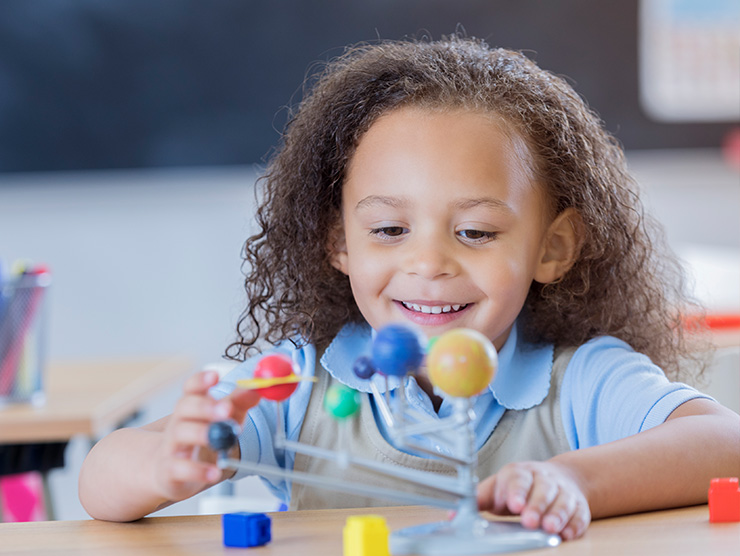As the seasons change from summer to fall, there is more than just the beauty of changing leaves to celebrate. Fall is a wonderful time for young children to engage in experiences that are enjoyable and enriching while incorporating the natural world around them.
Fall’s crisp air, falling leaves, and vibrant hues can leave anyone, regardless of age, in awe and inspiration and lend themselves beautifully to a learning framework where the child is at the center. Discovery Driven Learning® is Bright Horizons’ proven approach to teaching and learning, where learning is guided by children’s innate desire to make discoveries about themselves and the world around them. Our framework embraces children’s “whys?” and encourages our teachers to nurture the child’s natural curiosities while maintaining joy and trusting relationships.
Imagine you step outside on a cool fall morning. Red, yellow, and orange leaves slowly drift to the ground, some picked up and carried by the cool breeze. In the distance, you see a squirrel climbing a tree, its cheeks filled. If you listen closely, you can hear the rustling of leaves and earth under your feet. Now imagine that you are a child in this very scenario. What might you want to explore, collect, know more about? What might inspire you to create and innovate?
By exploring in nature and taking advantage of the fall season, children can develop their cognitive, emotional, social, and physical development. Take a look at some of these suggested fall activities and how they support your child’s learning alongside our Discovery Driven Learning framework.
Keep in mind that all activities suggested can be modified to meet the needs of your child and their developmental level. Let your creativity flow!
Babies
- Fall sun catchers. This activity is great for infants and older. Provide children with a small amount of tissue paper, fallen leaves, flower petals, or other natural materials. Allow children to explore freely while they rip and crinkle the paper. Ensure they are not putting the paper in their mouths! Observe what children do and engage in the narration of what your baby is exploring. Provide a piece of contact paper for your child to make their own collage. When complete, hang the contact paper on a bright window and observe the light that filters through. Want to extend this experience? Go on a nature scavenger hunt (see below!) before this activity to collect your materials together.
- What am I learning? Engaging with a trusted adult in this experience allows children to foster an array of skills. Not only are children strengthening their fine motor skills by tearing paper, picking up objects, and sticking them on contact paper, but they are also understanding concepts such as shape, color, and size, engaging their senses with natural materials, and developing their language and literacy skills with back and forth conversation (even if they aren’t verbally responding quite yet!) and gaining new vocabulary. We can’t forget to mention developing our flexibility in thinking and exposure to high-quality responsive and nurturing relationships.
Toddlers and Twos
- Threading. Geared for toddlers/twos and older, little hands can get creative during this activity. Attach a piece of string (12 inches or shorter) to a twig or craft stick for children to hold. Demonstrate how to hold the thread with one hand and an item to thread with the other. Use large items such as wooden rings, cut pool noodles, jar lid rings, or similar. Tape or tie the loose end of the string to another object to prevent threading items from falling off the string. Variation with leaves and twigs: invite children to thread leaves on a twig or longer piece of yarn attached to a twig for piercing a hole.
- What am I learning? When young children explore the objects they have in front of them, they are analyzing and assessing what they can do next. As they practice fine motor skills and eye-hand coordination, children may find themselves tapping into strategies for emotional self-regulation as frustration may set in when figuring out hand placement and how to thread. Open-ended questions that begin with “I wonder…” or “What would happen if…” exercise children’s cognitive and critical thinking muscles.
Preschool and Older
- Scavenger hunt. Provide a checklist of nature items local to your area. Be sure to include pictures to aid in the development of literacy skills. Go on a walk together to see how many things you can find from your list.
- Family pumpkin patch. After a trip to the farm, wash your pumpkins together while discussing how you’d like to decorate them. Using paint, markers, collage materials, and carving items, unleash your imagination as you create your own family pumpkin patch. Take photos to share with friends, or leave them on display outside of your home or approved public/community space.
- Fall family activity checklist. Have a family discussion about everyone’s favorite fall activities. Is it baking with grandma? Going on a nature hike? Jumping in a pile of leaves? Wearing your favorite sweater? Compile your answers onto a Family Fall Activity Checklist, working to see how many times this season you’re able to participate in these favorites. Be sure to reflect together each time about what made it special.
- What am I learning? In all of these experiences, young children are continuing to strengthen their abilities as life-long learners. Children are being encouraged to ask questions, share their thoughts and feelings, create goals and work toward them, and solve problems creatively.
For more information on Discovery Driven Learning and at-home activities, take a look at our resources.




